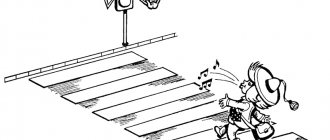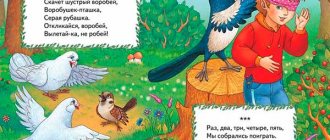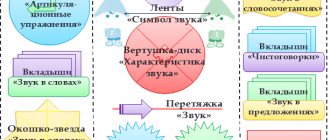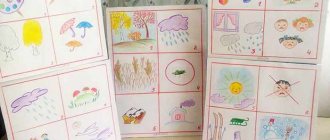Progress of the game:
We are sunbeams, mischievous people.
Sunny and I are dancing in a round dance.
We’ll run away, then we’ll hide, we just can’t be appeased,
Hey, Sunny - cheerful, try to catch up with us!
(Children stand in a circle, in the center of which is the Sun. Children move in a circle, responding to the words “hiding”
squat down.
Next they perform any dance movements, at the end of the singing the Sun tries to stain the players )
12. Cod and nets
(active game with singing for children 6-7 years old)
Selection of music games
The selection should be carried out with special care and take into account:
- age of the child(ren);
- the presence or absence of any musical knowledge and skills;
- equipment available for conducting classes.
We also note that educational musical games for children are provided free of charge by some Internet sites; It’s not difficult to download them, the main thing is to determine how accurately this or that game corresponds to the child’s age, as well as the goals and objectives set.
Properly selected and conducted musical didactic games significantly enrich the inner world of every child and contribute to his all-round development.
Outdoor games
Progress of the game:
Before the game starts, children form 2 circles, one in one. Those in the inner circle join hands - during the game they depict nets. The players in the outer circle do not hold hands; they are fish. To the music, the nets move in a round dance step to the right, and the fish one after another to the left (toe step, arms slightly pulled back, palms moving, imitating the movements of the fins).
Everyone sings:
“As fishermen went out to sea to fish for cod,
They set up the nets and sing a song.”
Then everyone stops. The players in the inner circle raise their joined hands up and sing: “Catch you, cod, get caught, get caught in our nets!”
A wonderful catch awaits the fishermen today!”
At this time, the players of the outer circle - the cod - can freely run in and out of the nets. The net cannot catch the fish.
At the last word of the song, the net is lowered, that is, all the players in the inner circle lower their joined hands down and squat. Caught "fish"
becomes an inner circle, which increases in size, after which the game resumes, or the players -
“fish”
and the players -
“nets”
change roles.
13 Autumn Leaves
Progress of the game:
In the hall there are autumn leaves from different trees on the floor (you can use real leaves or leaves made from cardboard)
Children with a calm step to the rhythm of the music walk around the hall in different directions between the leaves ( “walking in the forest”
) and sing:
“We are happily walking in the autumn forest,
We collect leaves, we know all the trees.”
Children stop and continue singing, alternately moving their right and left hands to the sides ( “pointing to the trees”
):
“Here is a birch, here is an aspen,
Poplar, maple, oak, rowan."
They clap their hands to the rhythm of the music and sing :
One, two three, one, two, three, pick up a piece of paper."
Each child picks up any one autumn leaf nearby.
The teacher calls the child's name. The child names his leaf: “I have a maple leaf.”
Note: The game can also be played in a circle
(in a round dance)
.
In this case, autumn leaves (according to the number
of children ) should be laid out inside the circle, and each child should pick up and name the leaf opposite which he stopped.
14 Mouse in the garden
Words and music by E. Kuznetsova.
From work experience “Using gaming technology in music classes at preschool educational institutions”
Municipal budgetary preschool educational institution
Child Development Center kindergarten
"Birch"
From work experience
“Use of gaming technology in music classes at preschool educational institutions”
musical director
1 sq. K. Ivanova S.I.
08.11.2019
Agapovka village
Play is not only fun and joy for a child, but also reinforces skills that he has recently mastered.
While playing, children learn about the world around them and adapt to the diversity of human relationships. Slide No. 2
Children play because they develop, and they develop because they play.
The essence of gaming activity is that it is not the result that is important, but the process itself, the process of experiences associated with gaming actions.
Thus, gaming technology plays a major role in the development of a child and is the foundation of all preschool education.
Slide No. 3
Problem:
Noting the lack of observation and creativity in some first-graders, psychologists often make the diagnosis: “didn’t finish the game,” i.e.
did not train his fantasy and imagination in the unpredictable and joyful process of the game. As a rule, such children do not know how to occupy themselves in their free time and look at the world around them without surprise and special interest, as consumers, and not as creators. Musical and play activity is a source of development of feelings, deep experiences and discoveries of the child, introduces him to spiritual values, and develops the emotional sphere of the child. Music and gaming technologies not only develop a child’s imagination, imagination and creativity. Children's creative manifestations in play activities are an important indicator of a child's musical development. The foundations of creative initiative are laid in childhood, so it is very important to encourage children’s desire to be different from others, to awaken their imagination, and to try to realize their creative individuality to the fullest.
The shortest way to emotionally liberate a child, relieve tension, and teach feeling and imagination is the path through play, fantasy, and writing. Musical and gaming activities can provide all this.
Particularly here we can highlight the work on theatrical activities, which is a synthesis of fiction, music, painting and concentrates the means of expression of these types of art, promotes the imagination and creativity, and intelligence of the child.
Slide No. 4
The relevance
of the topic I have chosen at the present stage is determined by the Federal State Educational Standards (federal state educational standards).
That is, pedagogy from “didactic becomes developmental”, which means the use of elements of gaming technologies, the development of musical creative abilities, improvisation in the process of teaching and raising children is becoming more and more noticeable, being one of the promising areas of pedagogical thought. Getting acquainted with modern ideas of developmental education, I understood their essence for myself, trying to adhere to its main principles: development, creativity, play. I support those pedagogical ideas, the essence of which boils down to a single concept: the development of a child can be understood as an active process of self-awareness, the active creation by a small person of his own personal biography. And an adult must help him - the teacher in this case - I, the music director, connected with him by common ties of assistance and cooperation.
Slide No. 5
The practical significance
lies in the fact that the accumulated material (planning, classes on music education, consultations for teachers and parents, etc.) can be used during holidays, entertainment, in the everyday life of children, in classes in circles.
Slide No. 6
The scientific novelty and theoretical significance of the experiment
lies in the consideration of the problem of developing the musical creative abilities of preschool children by means of musical and gaming art, in the development of forms and methods of working with children in music education classes, in the designation of the main directions of organizing musical and gaming technologies.
The concept of “game technologies” includes a fairly broad group of methods and techniques for organizing the pedagogical process in the form of various pedagogical games. Which generally differ from games in that they have a stated learning goal and a corresponding pedagogical result, which in turn are justified, highlighted explicitly and characterized by an educational-cognitive orientation. The game form of classes with the help of game techniques and situations should act as a means of motivating and stimulating children to learn.
Gaming technologies can be used in music classes as: an independent technology, as an element of a broader technology, as a lesson or part of it, or as a technology for cultural and leisure work.
Slide No. 7
Target:
Formation of musical abilities in children in an accessible playful form through musical play activities.
Tasks:
• Promote the acquisition of knowledge in musical and gaming activities.
• Develop children's natural musicality through play activities.
• The use of gaming technology in all types of musical activities: singing, listening, playing music, moving to music, etc.
• Conduct classes taking into account the age and individual abilities of children.
• Encourage the desire to take an active part in holidays and entertainment, using the skills acquired through musical games in the classroom.
• Develop communication skills and partnerships in children: teach them to correlate their interests and desires with the interests of other children.
Slide No. 8
Algorithm for music lessons and the use of gaming activities in my practice.
- Greetings.
- Musical and rhythmic movements.
- Development of a sense of rhythm, playing musical instruments.
- Finger gymnastics.
- Listening to music.
Fine movements and gestures, facial expressions. - Chanting, singing.
- Dance, game.
Slide No. 9
In my practice I try to focus on elements of theatrical improvisation and entertainment.
The process of gaming activity in music classes is inextricably linked with song creativity, in musical-rhythmic movements, in playing music, listening to music, i.e. elements of gaming technology are present in all types of musical activities.
Therefore, gaming technology has a special place in my work. It covers a certain part of the educational process, united by common content, plot, and characters.
Slide No. 10
For example, “Poultry yard” - I prepare attributes: a cockerel, a hen, a chick, cubes or rattles.
Greetings:
We say hello to the cockerel, hen and chicken - imitating their voices.
Musical and rhythmic movements.
We walk in small steps like chickens, like a hen, and like a cockerel - raising our legs high. We flap our wings.
We play noise instruments:
The cockerel is dancing in the hands of the teacher.
Finger games
: we show how a cockerel and a hen open their beaks.
Hearing:
Chicken. N. Lyubarsky
Singing:
Cockerel R.N.P., Chickens mus. A. Filippenko lyrics T Volgina. (Learning, dramatizing)
Dance:
Under R.N. melody, wave “Wings”, stomp, put your foot on the heel, etc. The teacher has a cockerel or chicken in his hand.
A game:
“And I, the strict cockerel, am the Golden Comb. I’ll catch up with you and drive you into the chicken coop!” The children are running, the Cockerel is catching up. - to cheerful music.
At the end of the lesson, Cockerel says goodbye to the children.
Slide No. 11
Greetings.
I usually start the lesson by singing and singing “Greetings”:
"Hello guys". The children respond by singing: “Hello!” Next I sing: “Hello, kittens!” Children: “Meow – meow – meow!”, “Hello, ducklings!”, “Quack – quack – quack”!” etc. Children happily join in the game, turning into frogs or kittens, learning onomatopoeia, clear diction, and learning to control the strength of their voice and timbre.
Musical and rhythmic movements.
I also use logorhythmic songs “Greetings”. For example: song - “Hello palms, clap, clap, clap.” - where children greet and demonstrate their body parts: (clap, stomp, stroke their cheeks, smack their lips, etc.)
“The legs started walking...”
The legs walked straight along the path - the children were walking at a marching pace.
And at the end of the path our legs stood up and stopped.
Say hello to everyone nearby.
Hello! Hello! - repeat again. -2 rub.
Slide No. 12
When using gaming technology in musical-rhythmic movements, I choose the most accessible and effective way to explain this musical-motor task.
In the process of games, children develop the skills necessary to display various emotions, moods, and individual character traits (“cowardly hare”, “cunning fox”). Children of younger groups master various types of walking, running and jumping.
When performing any dance movement, for example, “Spring,” you can use “proverbs”—rhymed poems describing the movement.
Slide No. 13
For example: SPRING.
In the clearing, two beetles danced hopaka.
They squatted and squatted, propping up their sides.
OPEN UP.
Open your arms wider, look at each other,
Open it slowly, the dance will be good!
Children of Junior Groups
learn figurative movements: “bear”, “bunny”, “fox”.
IN THE MIDDLE GROUP
cat (soft step), we get acquainted with Russian folk movements, dance with a handkerchief, master the movements of jumping, springing, jumping.
SENIOR GROUP
spring with a boat,
And in the PREPARATORY GROUP
mastering more and more new movements, we get acquainted with dances: Minuet, Polonaise, Polka, Waltz, etc. and perform the figures of these dances step by step, so that later we can put them together and perform them.
All these pictures are accompanied by game text and a list of movements for each age group.
Thus, the PRINCIPLE OF GAME LEARNING
successfully found its application in this type of musical activity.
It is simply necessary to make sure that in teaching musical-rhythmic movements everything is transparent and understandable to children, which will undoubtedly stimulate their interest and more successful reproduction of movements in music classes
To better convey to children the habits of animals and birds, I use motor improvisations, which I perform without prior preparation, with elements of rhythmoplasty.
Slide No. 14
Development of a sense of rhythm, playing musical instruments.
I work on rhythm with and without musical (noise) instruments.
I explain that rhythm is in everything: in music, in movements and words. Please say and clap your names, familiar rhymes, etc.
I believe that playing instruments is an interesting and useful musical activity for children. This allows you to decorate a child’s life, entertain him and arouse his desire for his own creativity. In the process of learning to play instruments, auditory perceptions, a sense of rhythm, timbre, and dynamics are well formed. The child develops independence in his actions, his attention and organization.
I support the initiative of improvisation on musical instruments. I help the children choose this or that instrument themselves, and with my advice they decide how to play it
(quiet or loud, slow or fast, and so on).
Slide No. 15 photo
Slide No. 16
Finger games
I use finger games, articulation exercises, and breathing exercises systematically, in every lesson. At their core, these games are original and of particular interest to children because they represent a miniature theater, where the actors are fingers, lips, and tongue.
Example: “We chop cabbage...”;
Slide No. 17
“The girl Zinochka has a full basket...”
In this I rely on a specially selected system of finger games, exercises, sketches for muscle relaxation, expressiveness of gestures, the ability to control one’s body (audio manuals by S. and E. Zheleznov.)
Exercises for proper breathing:
“Smell a flower,”
inhale short through your nose, exhale long through your mouth. “Airplane” - inhale through the nose - “Let’s refuel”, “Honk, fly” - “U-U-U” long exhale through the mouth - who will fly the longest.
Slide No. 18 Listening to music.
I invite the children to close their eyes and listen. At this time I turn on the phonogram “Sounds of the Forest”, “Doll’s Disease”, “Hunting” - September from the suite “The Seasons” by Tchaikovsky, etc. I suggest telling the children what they imagined while listening to the music. What kind of music: sad or happy; fast or slow, etc. Then I say the name of the musical work, show a portrait of the composer, and tell what the composer wrote the music about. And we compare the children’s ideas with the author’s intention.
Slide No. 19
In listening, the main goal is to hear the mood of a piece of music. Music should encourage a child to be creative. If children know how to listen to music, listen to its intonations, then they can easily convey the character of the music in singing and movements. Kids learn to hear the beginning and ending of musical phrases and small musical structures, and in the middle group, children can already analyze what they listen to, learn to compose a figurative story using means of musical expressiveness.
When children listen to musical works, I use the method of figurative play perception, i.e. a game situation is created in which children show their imagination and imagination (for example, while listening to the “March of the Wooden Soldiers” by P.I.Ch., children tap the meter rhythm with their hands on their knees, or they can stand up and march like soldiers. Listening to music, the child has the opportunity to convey its features in movements (general emotional mood, accents, tempo, rhythmic pattern, pauses, dynamics, etc.). I explain that when choosing movements, first of all, you need to listen to the nature of the music, which suggests the actions of individual characters. When listening to a piece of music, it is necessary to clearly emphasize the change in the nature of the music, conveying different images, to help the child find expressive movements and facial expressions.
Slide No. 20; 21; 22.
We work with the expressiveness of facial expressions like this: For example, I ask the children: “Do you know what “facial expressions” are? I listen to their answers and assumptions, then explain: “Facial expressions are a change in our face, and it changes with a change in mood. Show what your face looks like when you are: sad, surprised, angry, happy, etc.” (Children show.) When listening, I ask the children to show with their faces what kind of music (sad or happy).
“Now I’ll show you something, and you’ll try to guess what it means.” I show gestures “goodbye”, “hush”, “no”, “yes”, the children guess. “Can one of you tell me what the “language” in which I spoke to you is called?” Let me explain: “These are gestures. Sign language. Is it only used by actors? No. It is clear to us too.”
To better convey to children the habits of animals and birds, I use motor improvisations, which I perform without prior preparation, with elements of rhythmoplasty.
Children can perform simple exercises, sketches, for example, “galloping” like horses, kittens frolicking, etc. In this way, children experience music in motion, encouraging them to actively explore performance possibilities. Also in younger groups, children can perform simple sketches: after listening to music, I suggest taking a walk through a forest clearing (children enjoy walking, smelling flowers, collecting leaves), a dance sketch with imaginary toys, they learn figurative movements: “bear”, “bunny”, “fox” and other funny and sad hares, snowflakes spinning and falling to the ground. I draw attention to the fact that children convey their mood, change their facial expressions, etc.
Slide No. 23-26. Song
In my work, I first use songs that are simpler in content - chants, songs - noisemakers, I conduct speech exercises, the basis for which are counting rhymes, teasers, chants, nursery rhymes, jokes, I use elements of articulatory gymnastics, game songs.
The word and music are inseparable, since music attracts children to the basis of speech, makes them listen and think about the content of the song. To do this, I use song material that can be staged, performed in roles, that is, introduce elements of theatricality. For example: “There lived a prickly hedgehog in the forest” by N. Zaretskaya, I. Bodryachev,
In order for children to like the song, I try to present it brightly, expressively, with appropriate intonation and facial expressions.
I spend a lot of time on vocal training for children. Children really like to stage songs: “Pies”..., “Hedgehog with a Squirrel”...., “How a Crocodile Screams”, “About a Beetle” by O. Buynovskaya, I. Chernetskaya; “Droplets” (), and others. Before the performance, I conduct a conversation with the children, which sets them up to choose certain means of expression to convey a particular image.
Slide No. 27-30.
Dance
In dance creativity, I cultivate interest and desire to move in various images - animals, snowflakes, parsley, gnomes, etc. I use various attributes: flowers, leaves, ribbons, handkerchiefs, cubes, balls, etc.
In the process of musical and rhythmic education, I use the “Rhythmic Mosaic” program by A.I. Burenina, since it is aimed at developing the artistic and creative foundations of the individual, which contributes to the psychological emancipation of each child. The program includes a wide selection of dance and rhythmic compositions. Here are children's songs and melodies, famous music from films. Children have the opportunity to sing not only their favorite songs, but also dance to them. It gives them great joy, and if children enjoy doing it, then good results can always be expected.
Slide No. 31-32. Application of ICT
opens up great possibilities. Colorful educational presentations and viewing them on a multimedia screen help diversify the process of introducing children to the art of music, making the meeting with it more vibrant and interesting. Show what kinds of musical instruments there are, introduce children to musical professions, etc. We also use a multimedia screen to create various background settings necessary for entertainment (a forest with animals and birds appearing - conveying the atmosphere of a spring forest, or as a Background for May 9, etc.).
Slide No. 33; 34
It is important for me to introduce theatrical games, exercises, and sketches into children’s lives so that children can use these skills in free activity.
Slide No. 35; 36; 37.
I purchased and produced teaching aids that help in solving this problem. I made knitted character masks, mushrooms, leaves, etc. Such as card indexes: , “Journey into the world of emotions”; "Musical Games"; “Logori; “Preliminaries” - for dance movements; “Finger games”, etc. All this significantly improves the quality of work and stimulates children’s interest in this type of activity.
I try to compose holiday scenarios so that it includes theatrical performances with the participation of both children and adults (“Visiting the Bear”, “We are calling Autumn for a visit”, etc.).
The inclusion of gaming technology in musical activities brings positive results, since it is closely related to all sections of musical education - singing, moving to music, listening.
Of course, the work requires close communication with teachers and contact with parents. In them I always find support and mutual understanding.
Slide number 38. Results of using gaming technologies for music. classes:
- children learn and remember lesson material more easily;
- enjoy the game, show a desire to repeat it in independent activities;
- in the process of games, children gain special knowledge and skills.
- the level of development of children's cognitive activity and creative abilities increases.
Taking into account the analysis of my own experience, I came to the conclusion that the system of work carried out turned out to be the most optimal, adequate and effective in my work with children. Over the course of these two years, children showed off their achievements at festivals and entertainment. Their performances were distinguished by their bright, confident artistic performance. As a teacher, I am engaged in the development of children’s creative abilities and receive pleasure and joy from the very process of joint creative activity.
Slide No. 39. Methodological literature.
In the process of writing the experiment, the method of developing children's creativity in elementary music-making by K. Orff, the programs of N. A. Vetlugina, E. P. Kostina, E. A. Dubrovskaya, as well as the methodological developments of A. I. Burenina, N. Sorokina, A. V. Shchetkina, G. P. Novikova.
Radynova O.P. "Musical Masterpieces"
Radynova O.P. “Musical education of preschool children”,
Radynova O.P. "Listening to music"
E.G.Churilova “Methodology and organization of theatrical activities of preschool children”,
Vetlugina N.A. “Musical ABC Book” Slide No. 40 Thank you for your attention!





